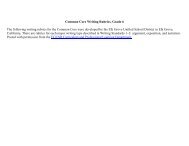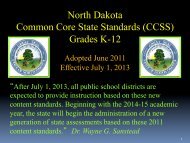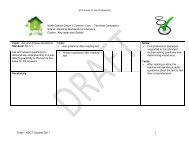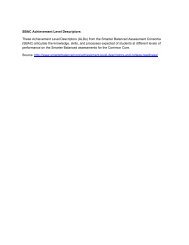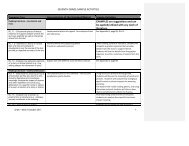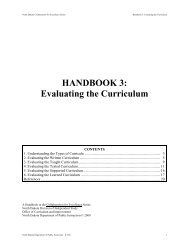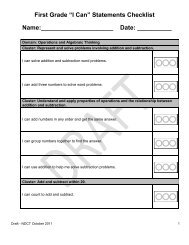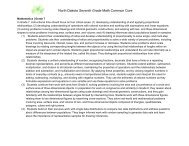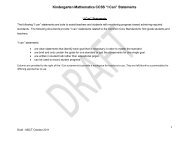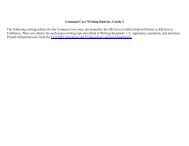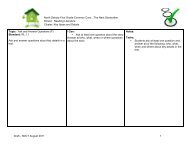A. ND Mathematics Content Standards, Grade 5 - ND Curriculum ...
A. ND Mathematics Content Standards, Grade 5 - ND Curriculum ...
A. ND Mathematics Content Standards, Grade 5 - ND Curriculum ...
You also want an ePaper? Increase the reach of your titles
YUMPU automatically turns print PDFs into web optimized ePapers that Google loves.
<strong>Mathematics</strong> | <strong>Grade</strong> 5<br />
In <strong>Grade</strong> 5, instructional time should focus on three critical areas: (1) developing fluency with addition and subtraction of fractions, and developing<br />
understanding of the multiplication of fractions and of division of fractions in limited cases (unit fractions divided by whole numbers and whole<br />
numbers divided by unit fractions); (2) extending division to 2-digit divisors, integrating decimal fractions into the place value system and<br />
developing understanding of operations with decimals to hundredths, and developing fluency with whole number and decimal operations; and (3)<br />
developing understanding of volume.<br />
(1) Students apply their understanding of fractions and fraction models to represent the addition and subtraction of fractions with unlike<br />
denominators as equivalent calculations with like denominators. They develop fluency in calculating sums and differences of fractions, and<br />
make reasonable estimates of them. Students also use the meaning of fractions, of multiplication and division, and the relati onship<br />
between multiplication and division to understand and explain why the procedures for multiplying and dividing frac tions make sense.<br />
(Note: this is limited to the case of dividing unit fractions by whole numbers and whole numbers by unit fractions.)<br />
(2) Students develop understanding of why division procedures work based on the meaning of base-ten numerals and properties of<br />
operations. They finalize fluency with multi-digit addition, subtraction, multiplication, and division. They apply their understandings of<br />
models for decimals, decimal notation, and properties of operations to add and subtract decimals to hundredths. They develop fluency in<br />
these computations, and make reasonable estimates of their results. Students use the relationship between decimals and fracti ons, as<br />
well as the relationship between finite decimals and whole numbers (i.e., a finite decimal multiplied by an appropriate power of 10 is a<br />
whole number), to understand and explain why the procedures for multiplying and dividing finite decimals make sense. They com pute<br />
products and quotients of decimals to hundredths.<br />
(3) Students recognize volume as an attribute of three-dimensional space. They understand that volume can be measured by finding the total<br />
number of same-size units of volume required to fill the space without gaps or overlaps. They understand that a 1-unit by 1-unit by 1-unit<br />
cube is the standard unit for measuring volume. They select appropriate units, strategies, and tools for solving problems that involve<br />
estimating and measuring volume. They decompose three-dimensional shapes and find volumes of right rectangular prisms by viewing<br />
them as decomposed into layers of arrays of cubes. They measure necessary attributes of shapes in order to determine volumes to solve<br />
real world and mathematical problems.<br />
North Dakota <strong>Mathematics</strong> <strong>Content</strong> <strong>Standards</strong><br />
Based on the Common Core State <strong>Standards</strong><br />
<strong>Grade</strong> 5 9 June 2011



